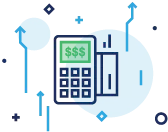
Using online payment gateways and other tools to process payments can help streamline the sales process for your business. However, credit card processors have security tools to prevent fraudulent transactions, which can sometimes cause legitimate transactions to be declined, thus lowering your authorization rate and subsequently increasing your credit card decline rate.
When your business declines a legitimate transaction, it may result in lost revenue and other issues. Likewise, customers experiencing any type of payment failure at your business may be less likely to return for future purchases. For businesses depending on recurring revenue, declined transactions are a significant problem. When a customer fails to manually update expired credit card details, it can result in automatic declines. Fortunately, various tools and payment strategies are available to help all types of businesses improve credit card authorization rates.
This guide explores declined credit card transactions, authorization rates, why authorization rates are critical to your business, and how you can lower your card decline ratio to retain more revenue. Read ahead if declined transactions are impacting your bottom line!
What Is a Declined Credit Card Transaction?
A declined credit card transaction happens when a payment processor or payment gateway declines to authorize a payment. When this occurs, the funds remain in the cardholder’s account, and the merchant receives no payment. This can happen for a variety of reasons—let’s explore some of the most common factors:
- Invalid Credit Card Details: If a customer inputs an incorrect card number or CVV, the payment processor will not process the transaction.
- Insufficient Funds: If a customer doesn’t have enough money in their account to honor the payment and there is no pre-arranged overdraft, the transaction will decline.
- Expired Credit Card: If a customer uses a credit card that has expired, it will likely decline. This is one of the most common reasons for recurring payment declines.
- Reported Lost/Stolen: If a credit card is reported lost or stolen, credit card processors will decline any future payments to prevent chargebacks and other payment issues.
- Suspected Fraud: Payment gateways use fraud detection methods to prevent scammers from using stolen credit card details. If a business’s fraud system picks up any suspicious activity, it may decline the transaction or request manual approval from the merchant.
There are other reasons a decline can occur. Payment processors will typically communicate a decline message or code to inform merchants why a particular transaction has declined.

What is a credit card decline rate?
Credit card decline rates refer to the ratio of credit card transactions declined compared to the overall number of attempted credit card transactions. For example, if your business attempts 100 transactions, and five of them are refused, your credit card decline rate is 5%. While many declined transactions are unavoidable, it’s critical a business doesn’t have an excessive decline ratio. Otherwise, they may be missing out on legitimate revenue. Keeping tabs on your credit card decline rate can help your business understand if there are any preventable payment issues contributing to a higher-than-usual decline frequency.
What Is an Authorization Rate?
An authorization rate is the opposite of a credit card decline rate. This figure refers to the ratio of authorized transactions compared to the total number of attempted payments. Using the same figures as before, if your business attempts 100 transactions and 95 are approved, your authorization rate is 95%. Merchant service providers may also refer to authorization rates as “auth rates” and “approval rates.”
As previously discussed, there are various reasons your business will not have a 100% authorization rate. Whether it’s customers inputting incorrect card details, shoppers forgetting they don’t have sufficient funds, or scammers using stolen credit card details, there’s always a chance a transaction will decline. In fact, if your credit card processor isn’t declining transactions, it may leave you open to fraud and chargebacks. Still, maintaining a healthy authorization rate is essential if you want your business to generate revenue from credit card payments.
Why Auth Rate Matters for Your Business
Authorization rates measure the success rate of verifying the authenticity of payment transactions. Let’s explore the key reason authorization rate is critical to your business’s success:
- Missed revenue: If a legitimate customer is turned down due to issues within your payment system, they may not re-attempt a purchase. This lost revenue can quickly add up and may impact your business’s ability to continue operating.
- Payment processing costs: Many merchant services providers charge authorization fees for declined transactions, meaning your business must pay money to your processor regardless of whether a transaction goes through or not. Excessive declined transactions can quickly become a frustrating expense.
- Indication of fraud: Businesses in high-risk industries must be careful to avoid stolen credit card details—not doing so may result in chargebacks and costly payment disputes. Always keep tabs on declined card transaction figures to spot if your business is becoming an increasingly popular target for fraud.
- Potential merchant account closure: If your business has an excessive declined payment ratio, it may indicate negligent business practices. Financial institutions may view this negatively and shut down your merchant account. Likewise, excessive declined transactions may exclude your business from low payment processing rate offers, creating long-term increases in transaction costs.
How to Manage Credit Card Declines
The correct approach for managing credit card declines depends on various factors. There are three primary types of credit card declines: soft declines, hard declines, and false declines. With hard declines, there is usually a significant reason to prevent authorization, such as the card number not existing or the customer providing an incorrect CVV code. In these instances, a merchant should be happy the acquirer refuses to process the transaction. Not doing so would leave the business open to a significant risk of chargebacks.
Soft declines occur when there is a reasonable level of suspicion about a charge, but it is not immediately clear the transaction is fraudulent. With a soft decline, a merchant can intervene and contact the customer to clarify any issues. If your credit card authorization rate is too low, tools are available to help you optimize your payment infrastructure to decline fewer transactions. We cover this in more detail in the section below.
A false decline, which could be a type of hard decline, occurs when a legitimate transaction is wrongly rejected by the credit card issuer, often due to suspicion of fraudulent activity or suspicious spending. To address these, consider implementing advanced fraud detection systems. Additionally, have a clear process for customers to contact you when they experience a false decline, and be ready to assist in resolving the issue.
How to Lower Card Decline Ratio & Raise Authorization Rates
Raising your authorization rate allows your business to retain more of its revenue. However, you shouldn’t lower your card decline ratio at all costs. Credit card fraud prevention tools are still essential for blocking scammers. Below, let’s explore four strategies for lowering decline ratios without increasing your chances of chargebacks:
1. Offer multiple payment options
First, offering payment flexibility to your customers can help lower card decline ratios. By providing multiple payment options, your business is allowing customers to self-select payment methods most suited to their payment preferences. For example, a customer may choose to pay with an alternative payment method like PayPal as they already have a PayPal digital wallet account. Accepting digital wallet payments in addition to standard payments can help you reduce your decline rate, as digital wallets contain pre-saved credit card details from the customer.
Not only will this help improve your business’s authorization rate, but it will also help gain attention from more customers. Evidence suggests more than 60% of consumers prefer shopping with merchants offering their preferred payment method.[1]CIO. “Consumers Want More Payment Flexibility in Their Shopping Experience“. Accessed on October 17, 2023 Payment flexibility can result in improved revenue for your business.
2. Utilize account updater software
Declined payments are a massive issue for businesses operating on a recurring billing business model. If a customer’s card details change or expire, future payments will not be authorized if the cardholder doesn’t update the details manually. Fortunately, there is now account updater software that automates this process and prevents transactions from declining. Account updater software searches for various changes in cardholder data, such as card brand updates, re-issued cards, account closures, and card upgrades.
3. Use fraud detection tools and indicators
Fraud detection tools are essential in combatting online scammers. While declined transactions are annoying, they are a crucial component in preventing fraudsters from using stolen credit card details to rob your business and innocent cardholders. Using robust fraud detection tools will help you decline fraudulent charges and accept legitimate purchases.
4. Reach out to customers proactively
Lastly, it’s critical to reach out to customers proactively if there are any payment issues. As previously discussed, “soft payment declines” don’t necessarily mean the payment is illegitimate. If there are reasons to be suspicious about a particular payment, get in contact with the customer to confirm details, such as billing address, phone number, and other core payment data. Robust communication can help you improve your business’s authorization rate without exposing it to fraud.
5. Utilize smart payment routing
Smart payment routing utilizes software to route payments to payment gateways or acquirers most suitable for a particular payment, reducing the number of unnecessary declined transactions. For example, if an overseas customer places an order on your website, smart payment routing would route the transaction to a payment processor with international payment options. Smart payment routing occurs instantly, so it doesn’t slow down the payment process for your customers. Likewise, smart payment routing settings can be customized by the merchant to meet specific needs.
How PaymentCloud Can Help with Authorization Rate Optimization
Increasing your authorization rate can drastically improve your business’s revenue. However, it’s essential that your strategies to increase card authorization don’t put your business at risk of fraud and chargebacks. Fortunately, at PaymentCloud, we have a wide range of credit card processing tools available to help our clients reduce declined transactions and retain additional cash flow.
From the moment you begin working with our team, a dedicated account manager will ensure your merchant account has all the resources it needs to authorize legitimate credit card transactions. Our payment products utilize smart routing, integrated systems, account updater software, fraud detection solutions, and a host of other tools to ensure your payment stack recognizes legitimate charges. Contact us today to speak about improving your card authorization ratio!
Auth Rate FAQs
What’s a good authorization rate to use as a benchmark?
Authorization rates vary significantly depending on your industry and business type. For example, high-risk and recurring revenue businesses experience higher card decline rates. Recurring payment businesses often have authorization rates of around 85%, while traditional businesses have authorization rates of approximately 95%.[2]Revolv3. “Recurring Decline Codes and the Imperfect Science of Reducing Churn“. Accessed on October 17, 2023.
Do merchants get charged for declined transactions?
The exact cost of a declined transaction will depend on a business’s merchant service provider. However, there are usually costs associated with declined transactions, making it essential to avoid rejecting legitimate purchases. Most merchant service providers will charge authorization fees, regardless of whether a transaction is approved or not. If your business has a low authorization rate, it’s worth investing in better payment infrastructure to increase approval rates.
Is having zero declined transactions possible?
No, there’s no chance any business generating considerable payment volume will be able to maintain zero declined transactions. There will always be instances in which customers input incorrect credit card information or use expired card details. However, declined transactions aren’t always bad news—if a transaction declines because a fraud prevention tool stops a scammer from completing a payment, it should be welcomed by your business.
What is the difference between the authorization rate and the conversion rate?
An authorization rate refers to the ratio of accepted payments in comparison to the ratio of attempted payments. On the other hand, a conversion rate refers to the number of customers that proceed with a transaction after engaging with an offer. For example, if a customer clicks on an advertisement and adds a product to their shopping cart, the conversion rate refers to how many individuals proceed to purchase the product in comparison to the overall number of people engaging with the offer.
A strong conversion rate is related to marketing materials, payment ease, and other factors. While an authorization rate is dependent on whether an acquirer accepts or declines a transaction.







